Capital Structure Impact on Ooredoo Oman's Financial Sustainability
VerifiedAdded on 2021/12/16
|10
|2236
|245
Report
AI Summary
This report analyzes the relationship between capital structure and financial sustainability, using Ooredoo Oman as a case study. It explores the components of capital structure, including debt and equity financing, and their implications for financial health. The report investigates the research problem of how Ooredoo Oman can ensure sustainability through an effective capital structure, focusing on debt-to-equity ratios and the minimization of insolvency risk. The study aims to determine the optimal debt-to-equity ratio for the company and how to mitigate risks associated with financial emergencies. The findings will provide insights for the business community, scholars, and managers, offering a framework for optimizing capital structure and achieving competitive advantages. The report highlights the importance of strategic financial planning, and the impact of capital structure decisions on financial performance. Finally, it examines the role of long-term debt and the benefits of various capital-raising methods to ensure financial stability and guide future research.
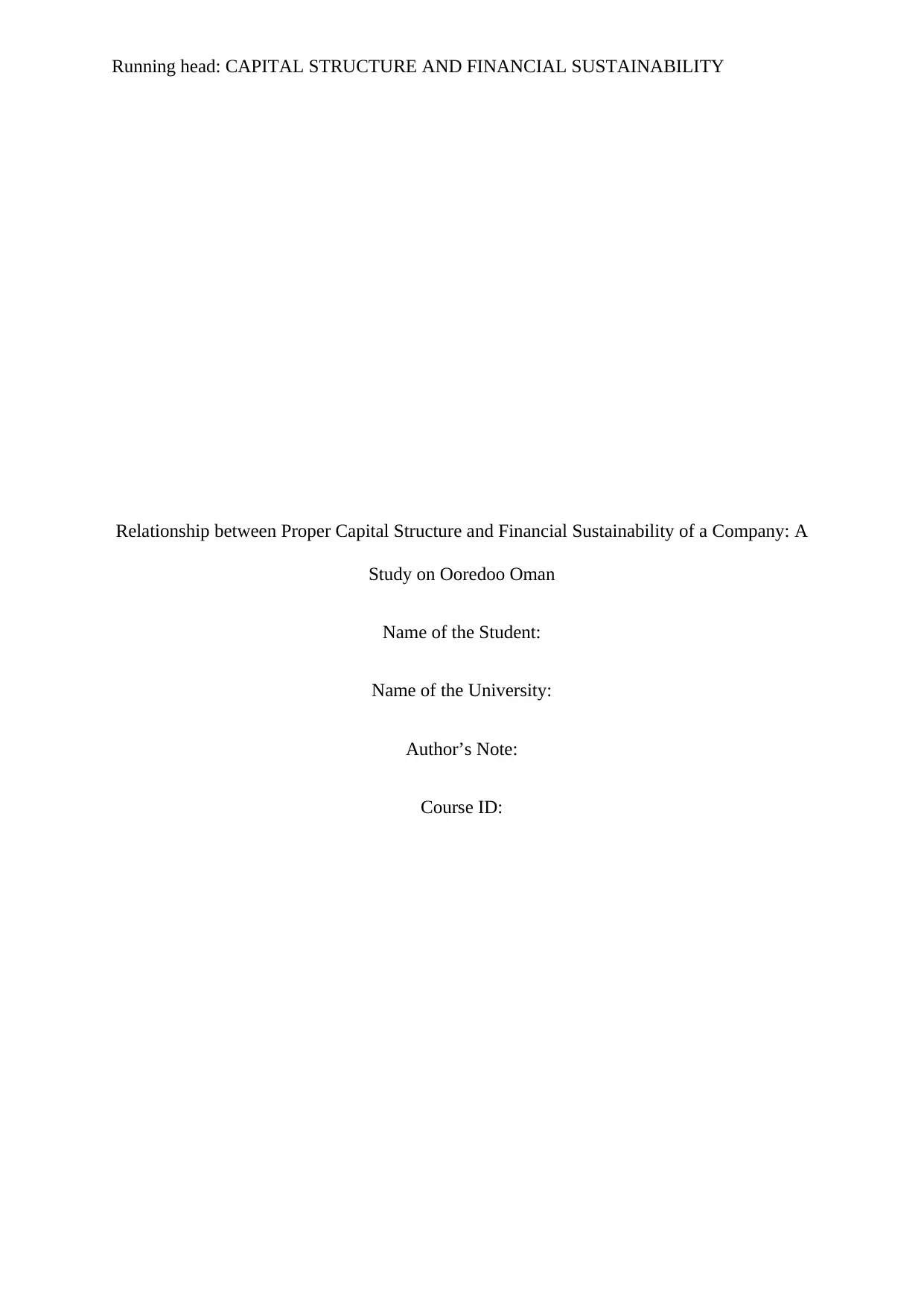
Running head: CAPITAL STRUCTURE AND FINANCIAL SUSTAINABILITY
Relationship between Proper Capital Structure and Financial Sustainability of a Company: A
Study on Ooredoo Oman
Name of the Student:
Name of the University:
Author’s Note:
Course ID:
Relationship between Proper Capital Structure and Financial Sustainability of a Company: A
Study on Ooredoo Oman
Name of the Student:
Name of the University:
Author’s Note:
Course ID:
Paraphrase This Document
Need a fresh take? Get an instant paraphrase of this document with our AI Paraphraser
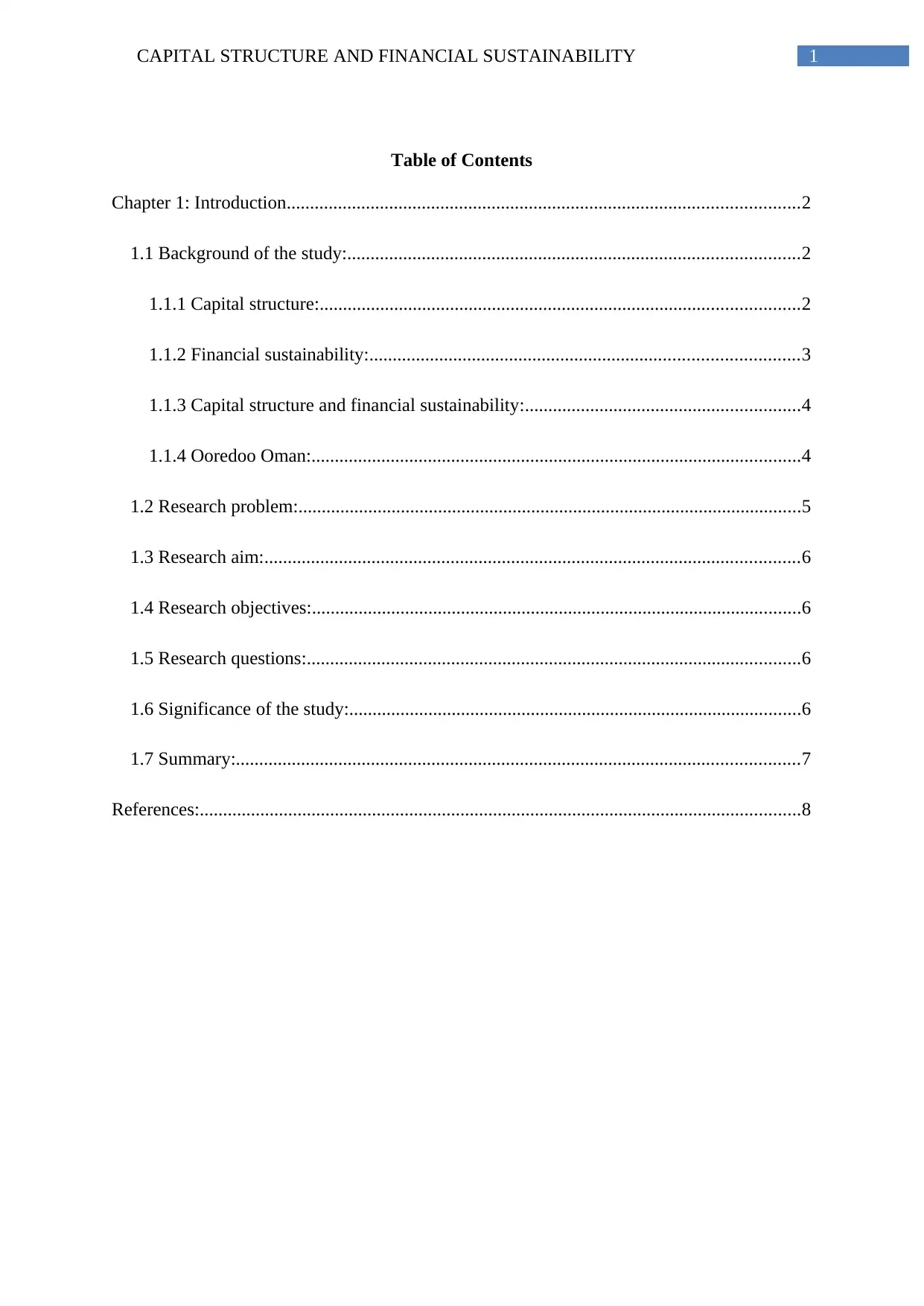
1CAPITAL STRUCTURE AND FINANCIAL SUSTAINABILITY
Table of Contents
Chapter 1: Introduction..............................................................................................................2
1.1 Background of the study:.................................................................................................2
1.1.1 Capital structure:.......................................................................................................2
1.1.2 Financial sustainability:............................................................................................3
1.1.3 Capital structure and financial sustainability:...........................................................4
1.1.4 Ooredoo Oman:.........................................................................................................4
1.2 Research problem:............................................................................................................5
1.3 Research aim:...................................................................................................................6
1.4 Research objectives:.........................................................................................................6
1.5 Research questions:..........................................................................................................6
1.6 Significance of the study:.................................................................................................6
1.7 Summary:.........................................................................................................................7
References:.................................................................................................................................8
Table of Contents
Chapter 1: Introduction..............................................................................................................2
1.1 Background of the study:.................................................................................................2
1.1.1 Capital structure:.......................................................................................................2
1.1.2 Financial sustainability:............................................................................................3
1.1.3 Capital structure and financial sustainability:...........................................................4
1.1.4 Ooredoo Oman:.........................................................................................................4
1.2 Research problem:............................................................................................................5
1.3 Research aim:...................................................................................................................6
1.4 Research objectives:.........................................................................................................6
1.5 Research questions:..........................................................................................................6
1.6 Significance of the study:.................................................................................................6
1.7 Summary:.........................................................................................................................7
References:.................................................................................................................................8
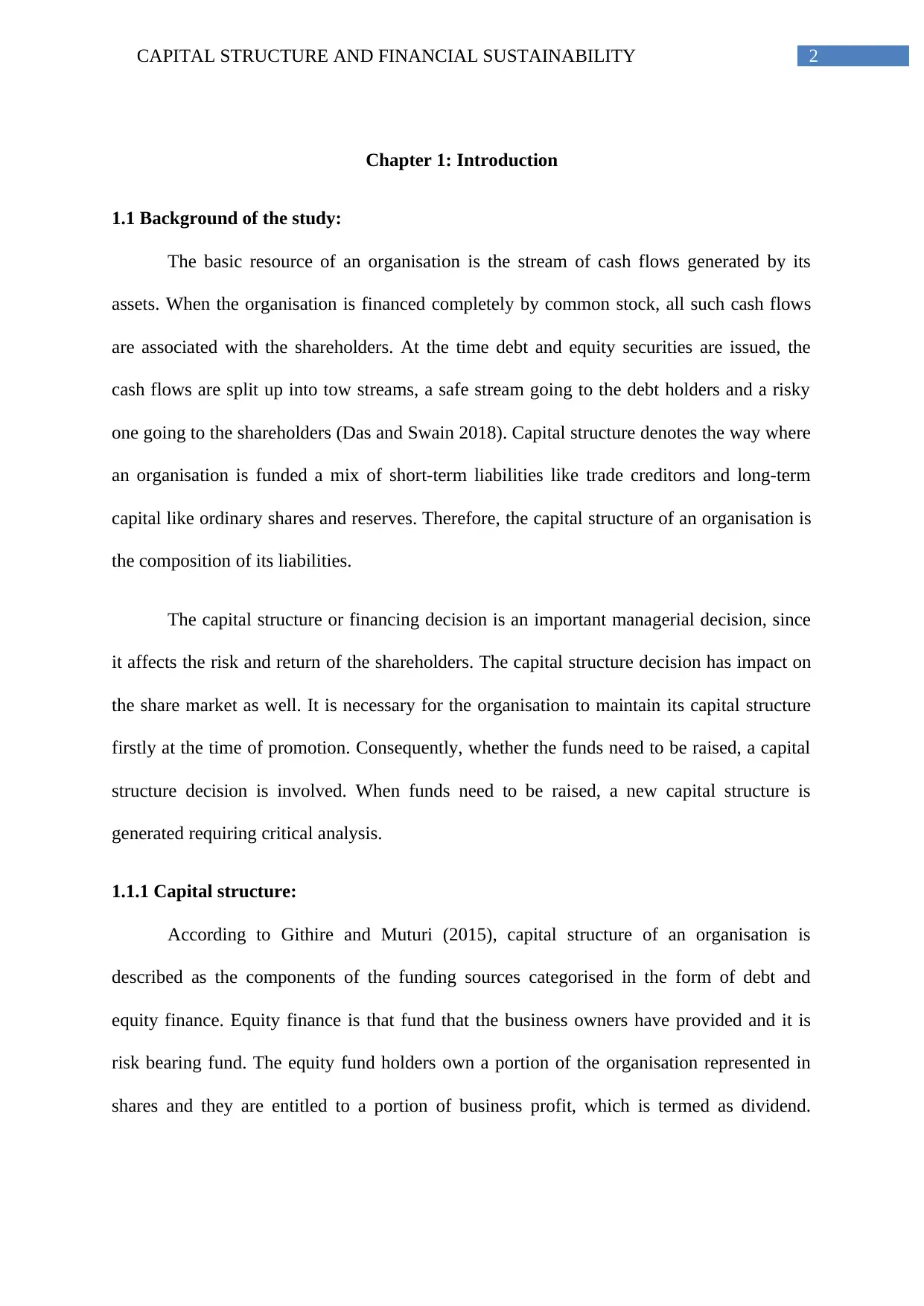
2CAPITAL STRUCTURE AND FINANCIAL SUSTAINABILITY
Chapter 1: Introduction
1.1 Background of the study:
The basic resource of an organisation is the stream of cash flows generated by its
assets. When the organisation is financed completely by common stock, all such cash flows
are associated with the shareholders. At the time debt and equity securities are issued, the
cash flows are split up into tow streams, a safe stream going to the debt holders and a risky
one going to the shareholders (Das and Swain 2018). Capital structure denotes the way where
an organisation is funded a mix of short-term liabilities like trade creditors and long-term
capital like ordinary shares and reserves. Therefore, the capital structure of an organisation is
the composition of its liabilities.
The capital structure or financing decision is an important managerial decision, since
it affects the risk and return of the shareholders. The capital structure decision has impact on
the share market as well. It is necessary for the organisation to maintain its capital structure
firstly at the time of promotion. Consequently, whether the funds need to be raised, a capital
structure decision is involved. When funds need to be raised, a new capital structure is
generated requiring critical analysis.
1.1.1 Capital structure:
According to Githire and Muturi (2015), capital structure of an organisation is
described as the components of the funding sources categorised in the form of debt and
equity finance. Equity finance is that fund that the business owners have provided and it is
risk bearing fund. The equity fund holders own a portion of the organisation represented in
shares and they are entitled to a portion of business profit, which is termed as dividend.
Chapter 1: Introduction
1.1 Background of the study:
The basic resource of an organisation is the stream of cash flows generated by its
assets. When the organisation is financed completely by common stock, all such cash flows
are associated with the shareholders. At the time debt and equity securities are issued, the
cash flows are split up into tow streams, a safe stream going to the debt holders and a risky
one going to the shareholders (Das and Swain 2018). Capital structure denotes the way where
an organisation is funded a mix of short-term liabilities like trade creditors and long-term
capital like ordinary shares and reserves. Therefore, the capital structure of an organisation is
the composition of its liabilities.
The capital structure or financing decision is an important managerial decision, since
it affects the risk and return of the shareholders. The capital structure decision has impact on
the share market as well. It is necessary for the organisation to maintain its capital structure
firstly at the time of promotion. Consequently, whether the funds need to be raised, a capital
structure decision is involved. When funds need to be raised, a new capital structure is
generated requiring critical analysis.
1.1.1 Capital structure:
According to Githire and Muturi (2015), capital structure of an organisation is
described as the components of the funding sources categorised in the form of debt and
equity finance. Equity finance is that fund that the business owners have provided and it is
risk bearing fund. The equity fund holders own a portion of the organisation represented in
shares and they are entitled to a portion of business profit, which is termed as dividend.
⊘ This is a preview!⊘
Do you want full access?
Subscribe today to unlock all pages.

Trusted by 1+ million students worldwide
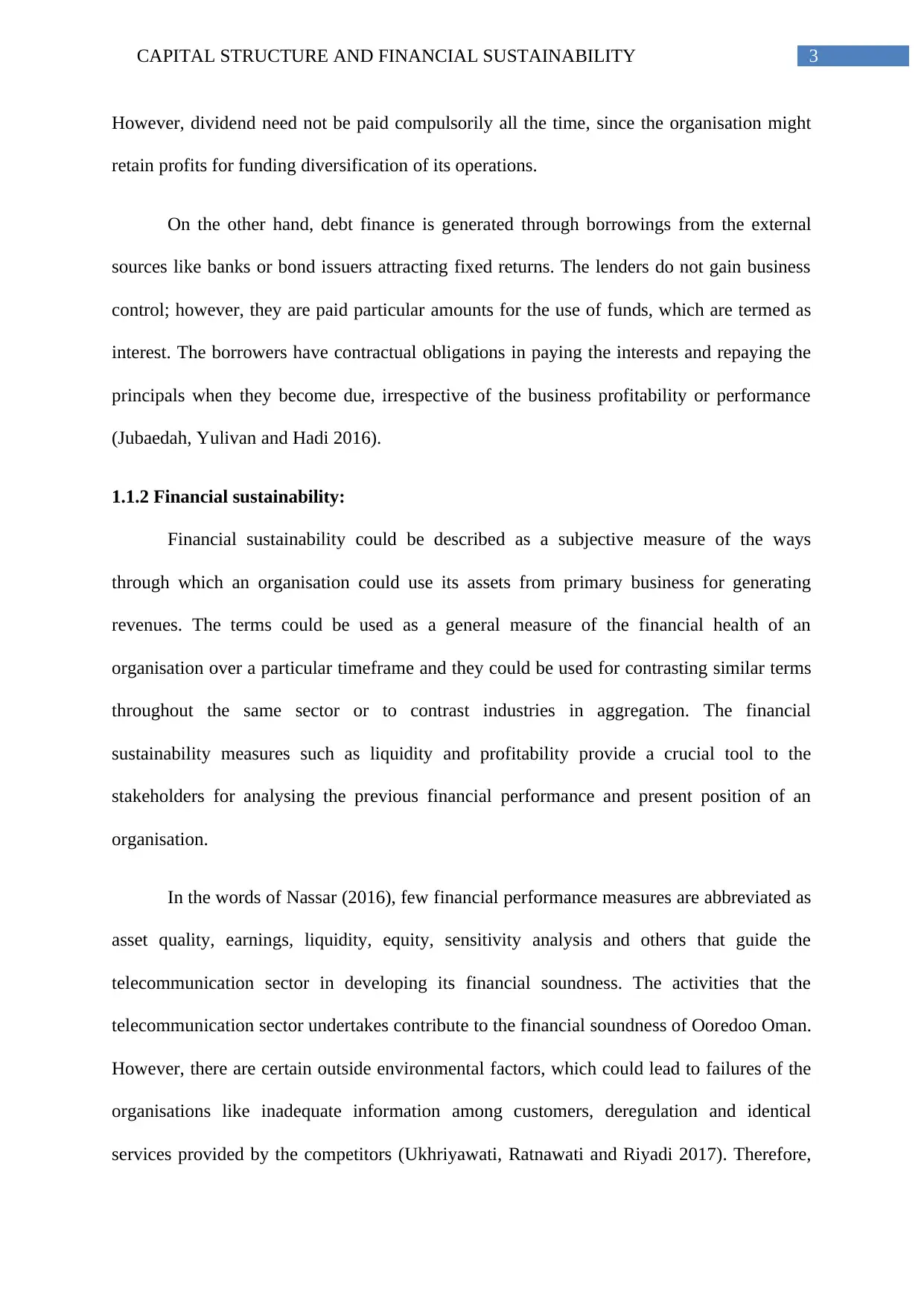
3CAPITAL STRUCTURE AND FINANCIAL SUSTAINABILITY
However, dividend need not be paid compulsorily all the time, since the organisation might
retain profits for funding diversification of its operations.
On the other hand, debt finance is generated through borrowings from the external
sources like banks or bond issuers attracting fixed returns. The lenders do not gain business
control; however, they are paid particular amounts for the use of funds, which are termed as
interest. The borrowers have contractual obligations in paying the interests and repaying the
principals when they become due, irrespective of the business profitability or performance
(Jubaedah, Yulivan and Hadi 2016).
1.1.2 Financial sustainability:
Financial sustainability could be described as a subjective measure of the ways
through which an organisation could use its assets from primary business for generating
revenues. The terms could be used as a general measure of the financial health of an
organisation over a particular timeframe and they could be used for contrasting similar terms
throughout the same sector or to contrast industries in aggregation. The financial
sustainability measures such as liquidity and profitability provide a crucial tool to the
stakeholders for analysing the previous financial performance and present position of an
organisation.
In the words of Nassar (2016), few financial performance measures are abbreviated as
asset quality, earnings, liquidity, equity, sensitivity analysis and others that guide the
telecommunication sector in developing its financial soundness. The activities that the
telecommunication sector undertakes contribute to the financial soundness of Ooredoo Oman.
However, there are certain outside environmental factors, which could lead to failures of the
organisations like inadequate information among customers, deregulation and identical
services provided by the competitors (Ukhriyawati, Ratnawati and Riyadi 2017). Therefore,
However, dividend need not be paid compulsorily all the time, since the organisation might
retain profits for funding diversification of its operations.
On the other hand, debt finance is generated through borrowings from the external
sources like banks or bond issuers attracting fixed returns. The lenders do not gain business
control; however, they are paid particular amounts for the use of funds, which are termed as
interest. The borrowers have contractual obligations in paying the interests and repaying the
principals when they become due, irrespective of the business profitability or performance
(Jubaedah, Yulivan and Hadi 2016).
1.1.2 Financial sustainability:
Financial sustainability could be described as a subjective measure of the ways
through which an organisation could use its assets from primary business for generating
revenues. The terms could be used as a general measure of the financial health of an
organisation over a particular timeframe and they could be used for contrasting similar terms
throughout the same sector or to contrast industries in aggregation. The financial
sustainability measures such as liquidity and profitability provide a crucial tool to the
stakeholders for analysing the previous financial performance and present position of an
organisation.
In the words of Nassar (2016), few financial performance measures are abbreviated as
asset quality, earnings, liquidity, equity, sensitivity analysis and others that guide the
telecommunication sector in developing its financial soundness. The activities that the
telecommunication sector undertakes contribute to the financial soundness of Ooredoo Oman.
However, there are certain outside environmental factors, which could lead to failures of the
organisations like inadequate information among customers, deregulation and identical
services provided by the competitors (Ukhriyawati, Ratnawati and Riyadi 2017). Therefore,
Paraphrase This Document
Need a fresh take? Get an instant paraphrase of this document with our AI Paraphraser
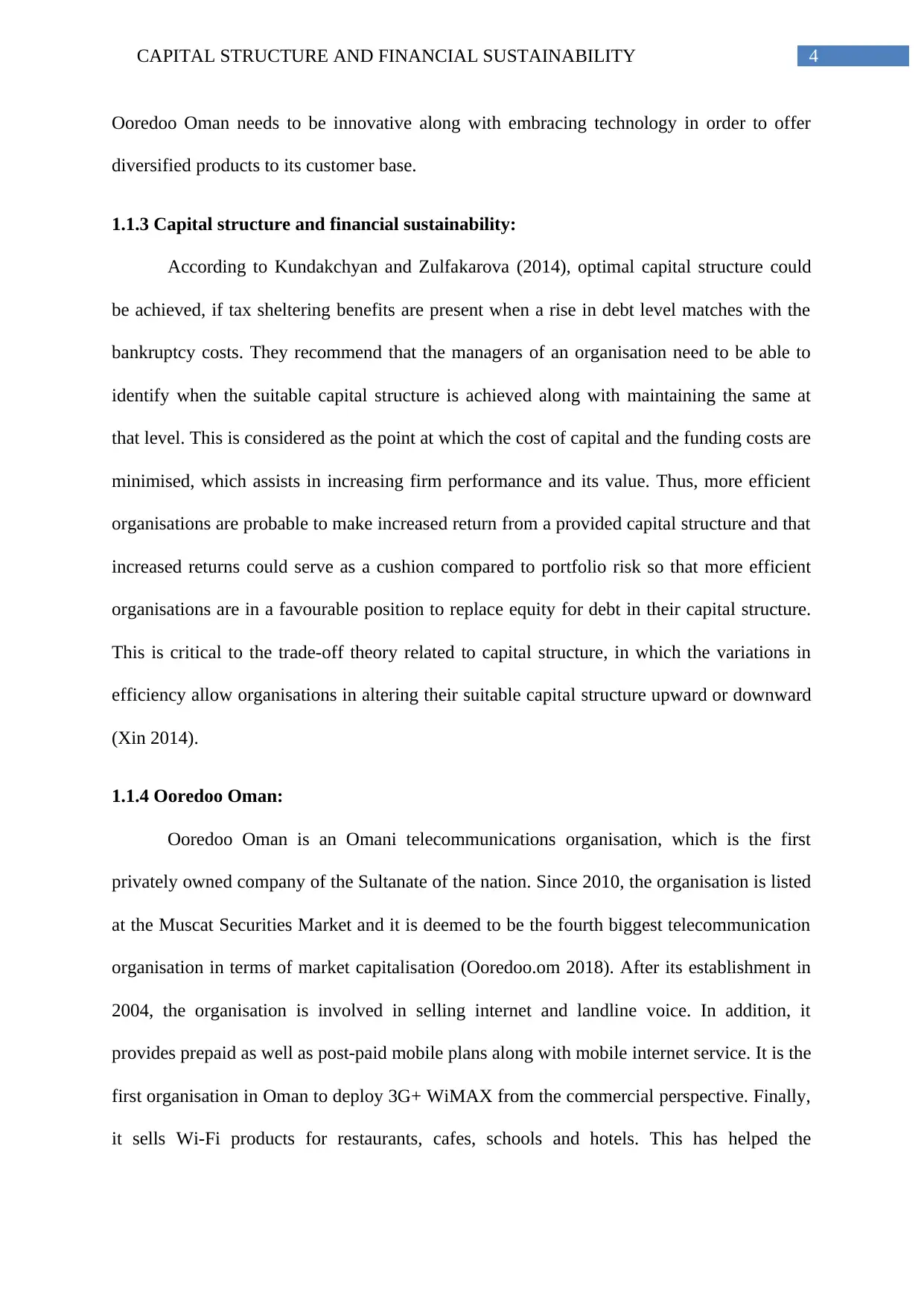
4CAPITAL STRUCTURE AND FINANCIAL SUSTAINABILITY
Ooredoo Oman needs to be innovative along with embracing technology in order to offer
diversified products to its customer base.
1.1.3 Capital structure and financial sustainability:
According to Kundakchyan and Zulfakarova (2014), optimal capital structure could
be achieved, if tax sheltering benefits are present when a rise in debt level matches with the
bankruptcy costs. They recommend that the managers of an organisation need to be able to
identify when the suitable capital structure is achieved along with maintaining the same at
that level. This is considered as the point at which the cost of capital and the funding costs are
minimised, which assists in increasing firm performance and its value. Thus, more efficient
organisations are probable to make increased return from a provided capital structure and that
increased returns could serve as a cushion compared to portfolio risk so that more efficient
organisations are in a favourable position to replace equity for debt in their capital structure.
This is critical to the trade-off theory related to capital structure, in which the variations in
efficiency allow organisations in altering their suitable capital structure upward or downward
(Xin 2014).
1.1.4 Ooredoo Oman:
Ooredoo Oman is an Omani telecommunications organisation, which is the first
privately owned company of the Sultanate of the nation. Since 2010, the organisation is listed
at the Muscat Securities Market and it is deemed to be the fourth biggest telecommunication
organisation in terms of market capitalisation (Ooredoo.om 2018). After its establishment in
2004, the organisation is involved in selling internet and landline voice. In addition, it
provides prepaid as well as post-paid mobile plans along with mobile internet service. It is the
first organisation in Oman to deploy 3G+ WiMAX from the commercial perspective. Finally,
it sells Wi-Fi products for restaurants, cafes, schools and hotels. This has helped the
Ooredoo Oman needs to be innovative along with embracing technology in order to offer
diversified products to its customer base.
1.1.3 Capital structure and financial sustainability:
According to Kundakchyan and Zulfakarova (2014), optimal capital structure could
be achieved, if tax sheltering benefits are present when a rise in debt level matches with the
bankruptcy costs. They recommend that the managers of an organisation need to be able to
identify when the suitable capital structure is achieved along with maintaining the same at
that level. This is considered as the point at which the cost of capital and the funding costs are
minimised, which assists in increasing firm performance and its value. Thus, more efficient
organisations are probable to make increased return from a provided capital structure and that
increased returns could serve as a cushion compared to portfolio risk so that more efficient
organisations are in a favourable position to replace equity for debt in their capital structure.
This is critical to the trade-off theory related to capital structure, in which the variations in
efficiency allow organisations in altering their suitable capital structure upward or downward
(Xin 2014).
1.1.4 Ooredoo Oman:
Ooredoo Oman is an Omani telecommunications organisation, which is the first
privately owned company of the Sultanate of the nation. Since 2010, the organisation is listed
at the Muscat Securities Market and it is deemed to be the fourth biggest telecommunication
organisation in terms of market capitalisation (Ooredoo.om 2018). After its establishment in
2004, the organisation is involved in selling internet and landline voice. In addition, it
provides prepaid as well as post-paid mobile plans along with mobile internet service. It is the
first organisation in Oman to deploy 3G+ WiMAX from the commercial perspective. Finally,
it sells Wi-Fi products for restaurants, cafes, schools and hotels. This has helped the
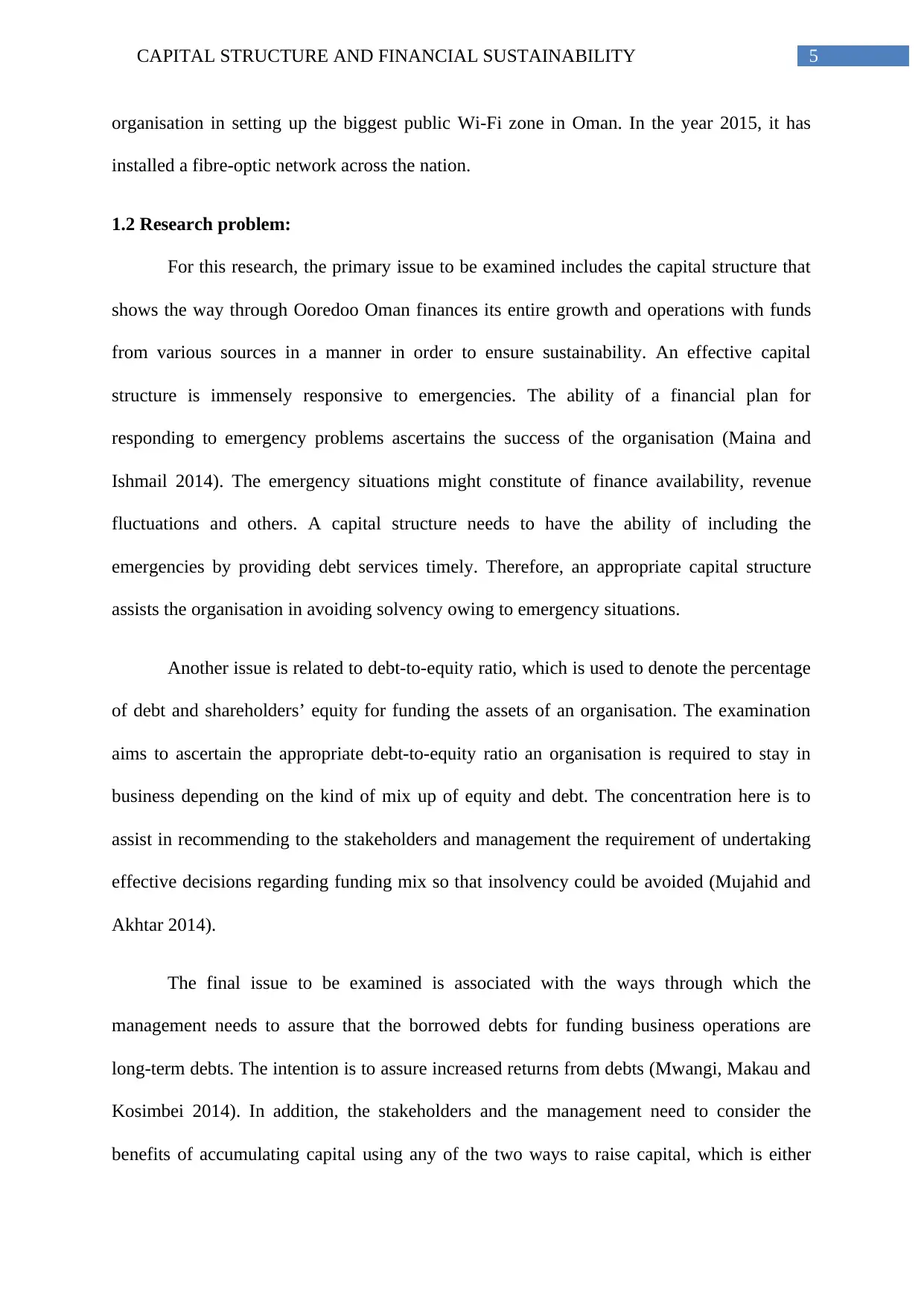
5CAPITAL STRUCTURE AND FINANCIAL SUSTAINABILITY
organisation in setting up the biggest public Wi-Fi zone in Oman. In the year 2015, it has
installed a fibre-optic network across the nation.
1.2 Research problem:
For this research, the primary issue to be examined includes the capital structure that
shows the way through Ooredoo Oman finances its entire growth and operations with funds
from various sources in a manner in order to ensure sustainability. An effective capital
structure is immensely responsive to emergencies. The ability of a financial plan for
responding to emergency problems ascertains the success of the organisation (Maina and
Ishmail 2014). The emergency situations might constitute of finance availability, revenue
fluctuations and others. A capital structure needs to have the ability of including the
emergencies by providing debt services timely. Therefore, an appropriate capital structure
assists the organisation in avoiding solvency owing to emergency situations.
Another issue is related to debt-to-equity ratio, which is used to denote the percentage
of debt and shareholders’ equity for funding the assets of an organisation. The examination
aims to ascertain the appropriate debt-to-equity ratio an organisation is required to stay in
business depending on the kind of mix up of equity and debt. The concentration here is to
assist in recommending to the stakeholders and management the requirement of undertaking
effective decisions regarding funding mix so that insolvency could be avoided (Mujahid and
Akhtar 2014).
The final issue to be examined is associated with the ways through which the
management needs to assure that the borrowed debts for funding business operations are
long-term debts. The intention is to assure increased returns from debts (Mwangi, Makau and
Kosimbei 2014). In addition, the stakeholders and the management need to consider the
benefits of accumulating capital using any of the two ways to raise capital, which is either
organisation in setting up the biggest public Wi-Fi zone in Oman. In the year 2015, it has
installed a fibre-optic network across the nation.
1.2 Research problem:
For this research, the primary issue to be examined includes the capital structure that
shows the way through Ooredoo Oman finances its entire growth and operations with funds
from various sources in a manner in order to ensure sustainability. An effective capital
structure is immensely responsive to emergencies. The ability of a financial plan for
responding to emergency problems ascertains the success of the organisation (Maina and
Ishmail 2014). The emergency situations might constitute of finance availability, revenue
fluctuations and others. A capital structure needs to have the ability of including the
emergencies by providing debt services timely. Therefore, an appropriate capital structure
assists the organisation in avoiding solvency owing to emergency situations.
Another issue is related to debt-to-equity ratio, which is used to denote the percentage
of debt and shareholders’ equity for funding the assets of an organisation. The examination
aims to ascertain the appropriate debt-to-equity ratio an organisation is required to stay in
business depending on the kind of mix up of equity and debt. The concentration here is to
assist in recommending to the stakeholders and management the requirement of undertaking
effective decisions regarding funding mix so that insolvency could be avoided (Mujahid and
Akhtar 2014).
The final issue to be examined is associated with the ways through which the
management needs to assure that the borrowed debts for funding business operations are
long-term debts. The intention is to assure increased returns from debts (Mwangi, Makau and
Kosimbei 2014). In addition, the stakeholders and the management need to consider the
benefits of accumulating capital using any of the two ways to raise capital, which is either
⊘ This is a preview!⊘
Do you want full access?
Subscribe today to unlock all pages.

Trusted by 1+ million students worldwide
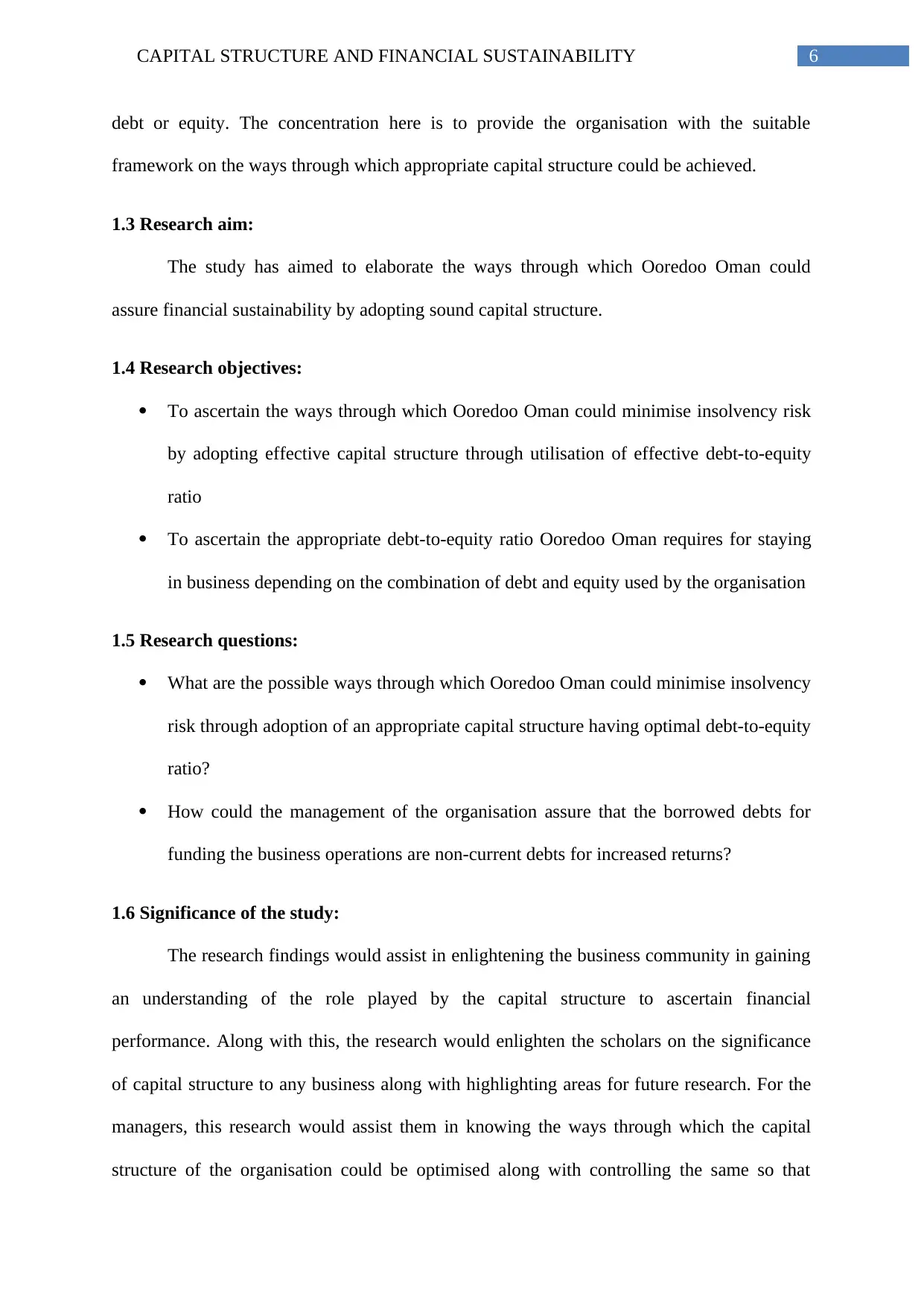
6CAPITAL STRUCTURE AND FINANCIAL SUSTAINABILITY
debt or equity. The concentration here is to provide the organisation with the suitable
framework on the ways through which appropriate capital structure could be achieved.
1.3 Research aim:
The study has aimed to elaborate the ways through which Ooredoo Oman could
assure financial sustainability by adopting sound capital structure.
1.4 Research objectives:
To ascertain the ways through which Ooredoo Oman could minimise insolvency risk
by adopting effective capital structure through utilisation of effective debt-to-equity
ratio
To ascertain the appropriate debt-to-equity ratio Ooredoo Oman requires for staying
in business depending on the combination of debt and equity used by the organisation
1.5 Research questions:
What are the possible ways through which Ooredoo Oman could minimise insolvency
risk through adoption of an appropriate capital structure having optimal debt-to-equity
ratio?
How could the management of the organisation assure that the borrowed debts for
funding the business operations are non-current debts for increased returns?
1.6 Significance of the study:
The research findings would assist in enlightening the business community in gaining
an understanding of the role played by the capital structure to ascertain financial
performance. Along with this, the research would enlighten the scholars on the significance
of capital structure to any business along with highlighting areas for future research. For the
managers, this research would assist them in knowing the ways through which the capital
structure of the organisation could be optimised along with controlling the same so that
debt or equity. The concentration here is to provide the organisation with the suitable
framework on the ways through which appropriate capital structure could be achieved.
1.3 Research aim:
The study has aimed to elaborate the ways through which Ooredoo Oman could
assure financial sustainability by adopting sound capital structure.
1.4 Research objectives:
To ascertain the ways through which Ooredoo Oman could minimise insolvency risk
by adopting effective capital structure through utilisation of effective debt-to-equity
ratio
To ascertain the appropriate debt-to-equity ratio Ooredoo Oman requires for staying
in business depending on the combination of debt and equity used by the organisation
1.5 Research questions:
What are the possible ways through which Ooredoo Oman could minimise insolvency
risk through adoption of an appropriate capital structure having optimal debt-to-equity
ratio?
How could the management of the organisation assure that the borrowed debts for
funding the business operations are non-current debts for increased returns?
1.6 Significance of the study:
The research findings would assist in enlightening the business community in gaining
an understanding of the role played by the capital structure to ascertain financial
performance. Along with this, the research would enlighten the scholars on the significance
of capital structure to any business along with highlighting areas for future research. For the
managers, this research would assist them in knowing the ways through which the capital
structure of the organisation could be optimised along with controlling the same so that
Paraphrase This Document
Need a fresh take? Get an instant paraphrase of this document with our AI Paraphraser
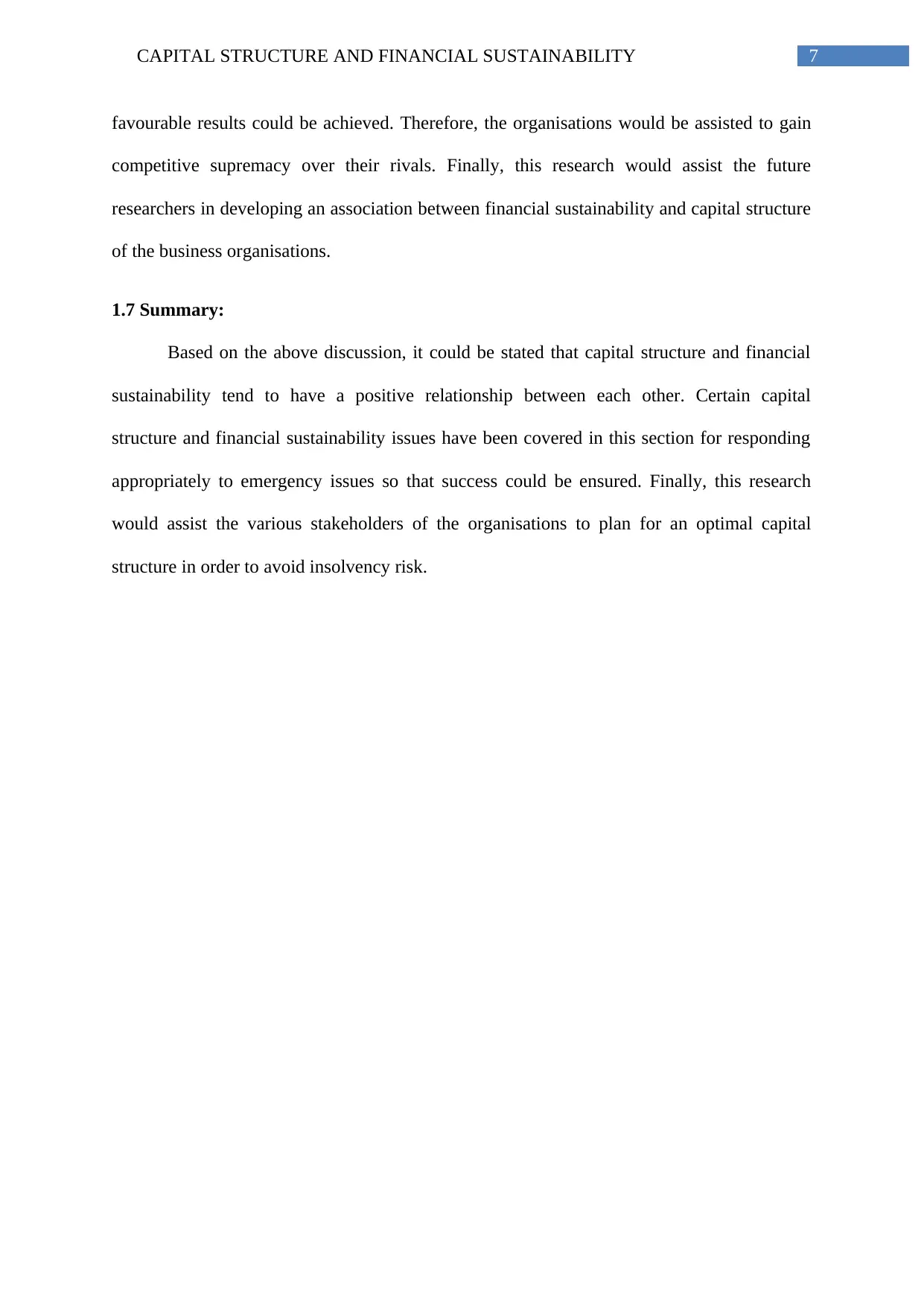
7CAPITAL STRUCTURE AND FINANCIAL SUSTAINABILITY
favourable results could be achieved. Therefore, the organisations would be assisted to gain
competitive supremacy over their rivals. Finally, this research would assist the future
researchers in developing an association between financial sustainability and capital structure
of the business organisations.
1.7 Summary:
Based on the above discussion, it could be stated that capital structure and financial
sustainability tend to have a positive relationship between each other. Certain capital
structure and financial sustainability issues have been covered in this section for responding
appropriately to emergency issues so that success could be ensured. Finally, this research
would assist the various stakeholders of the organisations to plan for an optimal capital
structure in order to avoid insolvency risk.
favourable results could be achieved. Therefore, the organisations would be assisted to gain
competitive supremacy over their rivals. Finally, this research would assist the future
researchers in developing an association between financial sustainability and capital structure
of the business organisations.
1.7 Summary:
Based on the above discussion, it could be stated that capital structure and financial
sustainability tend to have a positive relationship between each other. Certain capital
structure and financial sustainability issues have been covered in this section for responding
appropriately to emergency issues so that success could be ensured. Finally, this research
would assist the various stakeholders of the organisations to plan for an optimal capital
structure in order to avoid insolvency risk.
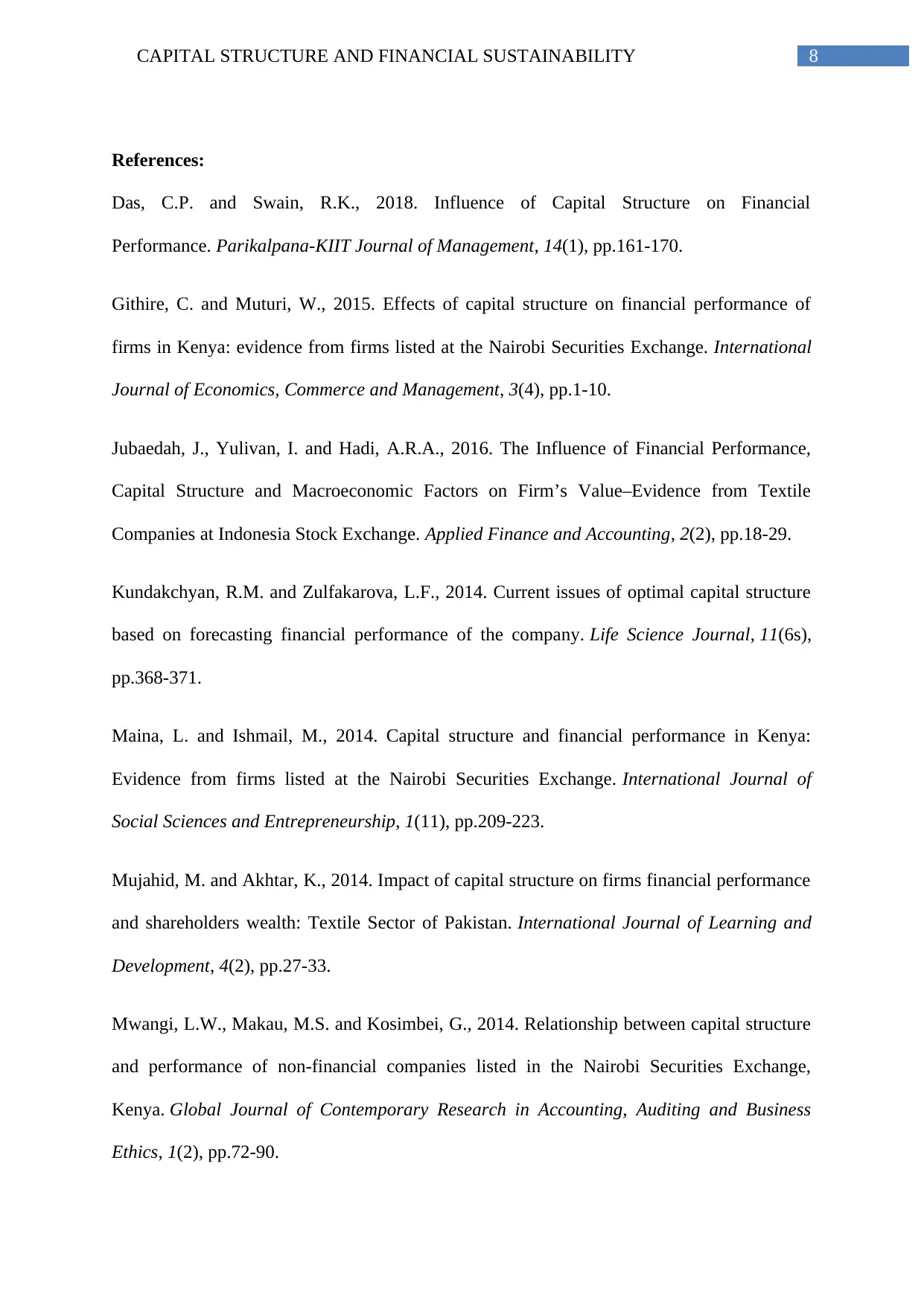
8CAPITAL STRUCTURE AND FINANCIAL SUSTAINABILITY
References:
Das, C.P. and Swain, R.K., 2018. Influence of Capital Structure on Financial
Performance. Parikalpana-KIIT Journal of Management, 14(1), pp.161-170.
Githire, C. and Muturi, W., 2015. Effects of capital structure on financial performance of
firms in Kenya: evidence from firms listed at the Nairobi Securities Exchange. International
Journal of Economics, Commerce and Management, 3(4), pp.1-10.
Jubaedah, J., Yulivan, I. and Hadi, A.R.A., 2016. The Influence of Financial Performance,
Capital Structure and Macroeconomic Factors on Firm’s Value–Evidence from Textile
Companies at Indonesia Stock Exchange. Applied Finance and Accounting, 2(2), pp.18-29.
Kundakchyan, R.M. and Zulfakarova, L.F., 2014. Current issues of optimal capital structure
based on forecasting financial performance of the company. Life Science Journal, 11(6s),
pp.368-371.
Maina, L. and Ishmail, M., 2014. Capital structure and financial performance in Kenya:
Evidence from firms listed at the Nairobi Securities Exchange. International Journal of
Social Sciences and Entrepreneurship, 1(11), pp.209-223.
Mujahid, M. and Akhtar, K., 2014. Impact of capital structure on firms financial performance
and shareholders wealth: Textile Sector of Pakistan. International Journal of Learning and
Development, 4(2), pp.27-33.
Mwangi, L.W., Makau, M.S. and Kosimbei, G., 2014. Relationship between capital structure
and performance of non-financial companies listed in the Nairobi Securities Exchange,
Kenya. Global Journal of Contemporary Research in Accounting, Auditing and Business
Ethics, 1(2), pp.72-90.
References:
Das, C.P. and Swain, R.K., 2018. Influence of Capital Structure on Financial
Performance. Parikalpana-KIIT Journal of Management, 14(1), pp.161-170.
Githire, C. and Muturi, W., 2015. Effects of capital structure on financial performance of
firms in Kenya: evidence from firms listed at the Nairobi Securities Exchange. International
Journal of Economics, Commerce and Management, 3(4), pp.1-10.
Jubaedah, J., Yulivan, I. and Hadi, A.R.A., 2016. The Influence of Financial Performance,
Capital Structure and Macroeconomic Factors on Firm’s Value–Evidence from Textile
Companies at Indonesia Stock Exchange. Applied Finance and Accounting, 2(2), pp.18-29.
Kundakchyan, R.M. and Zulfakarova, L.F., 2014. Current issues of optimal capital structure
based on forecasting financial performance of the company. Life Science Journal, 11(6s),
pp.368-371.
Maina, L. and Ishmail, M., 2014. Capital structure and financial performance in Kenya:
Evidence from firms listed at the Nairobi Securities Exchange. International Journal of
Social Sciences and Entrepreneurship, 1(11), pp.209-223.
Mujahid, M. and Akhtar, K., 2014. Impact of capital structure on firms financial performance
and shareholders wealth: Textile Sector of Pakistan. International Journal of Learning and
Development, 4(2), pp.27-33.
Mwangi, L.W., Makau, M.S. and Kosimbei, G., 2014. Relationship between capital structure
and performance of non-financial companies listed in the Nairobi Securities Exchange,
Kenya. Global Journal of Contemporary Research in Accounting, Auditing and Business
Ethics, 1(2), pp.72-90.
⊘ This is a preview!⊘
Do you want full access?
Subscribe today to unlock all pages.

Trusted by 1+ million students worldwide
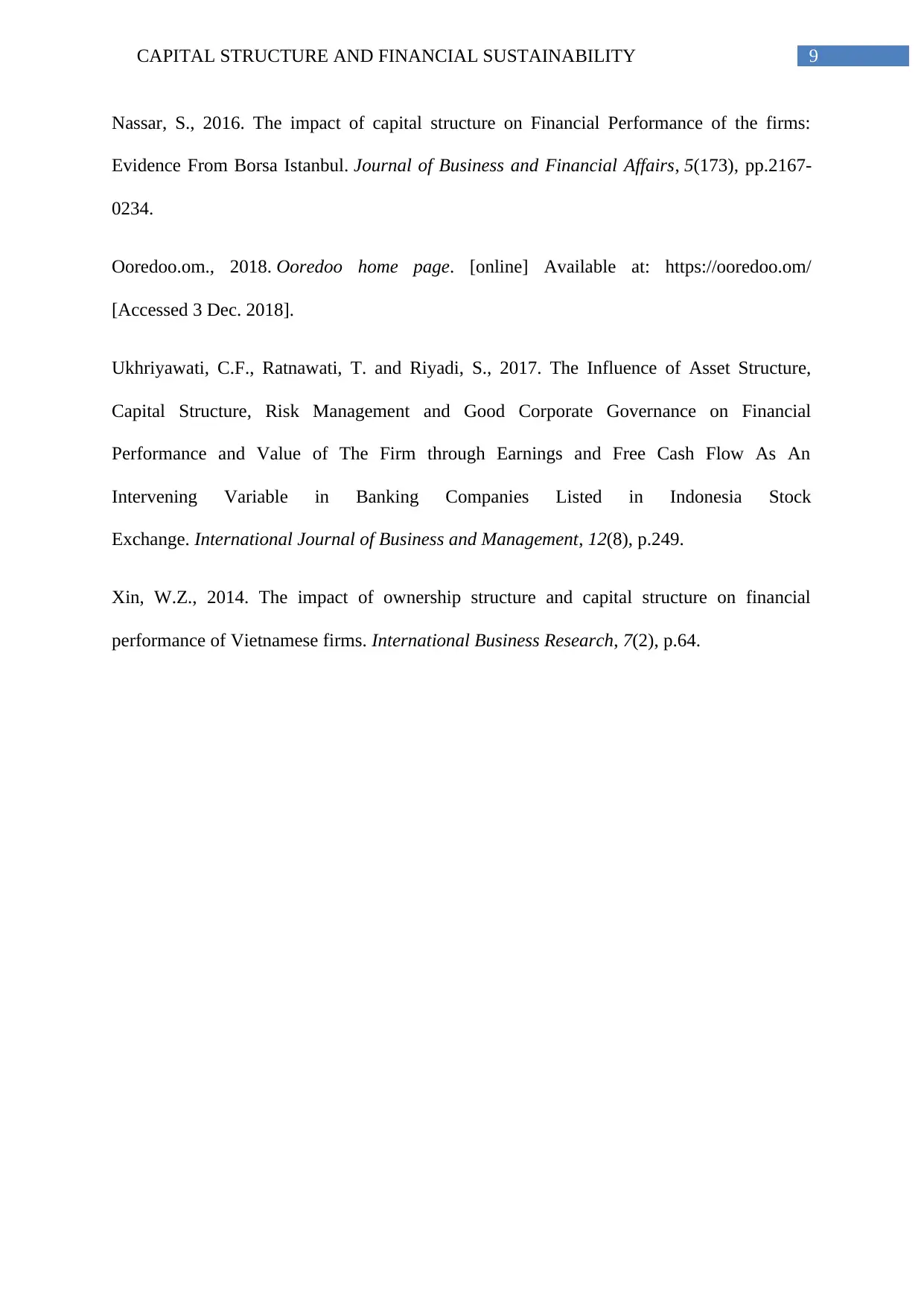
9CAPITAL STRUCTURE AND FINANCIAL SUSTAINABILITY
Nassar, S., 2016. The impact of capital structure on Financial Performance of the firms:
Evidence From Borsa Istanbul. Journal of Business and Financial Affairs, 5(173), pp.2167-
0234.
Ooredoo.om., 2018. Ooredoo home page. [online] Available at: https://ooredoo.om/
[Accessed 3 Dec. 2018].
Ukhriyawati, C.F., Ratnawati, T. and Riyadi, S., 2017. The Influence of Asset Structure,
Capital Structure, Risk Management and Good Corporate Governance on Financial
Performance and Value of The Firm through Earnings and Free Cash Flow As An
Intervening Variable in Banking Companies Listed in Indonesia Stock
Exchange. International Journal of Business and Management, 12(8), p.249.
Xin, W.Z., 2014. The impact of ownership structure and capital structure on financial
performance of Vietnamese firms. International Business Research, 7(2), p.64.
Nassar, S., 2016. The impact of capital structure on Financial Performance of the firms:
Evidence From Borsa Istanbul. Journal of Business and Financial Affairs, 5(173), pp.2167-
0234.
Ooredoo.om., 2018. Ooredoo home page. [online] Available at: https://ooredoo.om/
[Accessed 3 Dec. 2018].
Ukhriyawati, C.F., Ratnawati, T. and Riyadi, S., 2017. The Influence of Asset Structure,
Capital Structure, Risk Management and Good Corporate Governance on Financial
Performance and Value of The Firm through Earnings and Free Cash Flow As An
Intervening Variable in Banking Companies Listed in Indonesia Stock
Exchange. International Journal of Business and Management, 12(8), p.249.
Xin, W.Z., 2014. The impact of ownership structure and capital structure on financial
performance of Vietnamese firms. International Business Research, 7(2), p.64.
1 out of 10
Related Documents
Your All-in-One AI-Powered Toolkit for Academic Success.
+13062052269
info@desklib.com
Available 24*7 on WhatsApp / Email
![[object Object]](/_next/static/media/star-bottom.7253800d.svg)
Unlock your academic potential
Copyright © 2020–2025 A2Z Services. All Rights Reserved. Developed and managed by ZUCOL.





